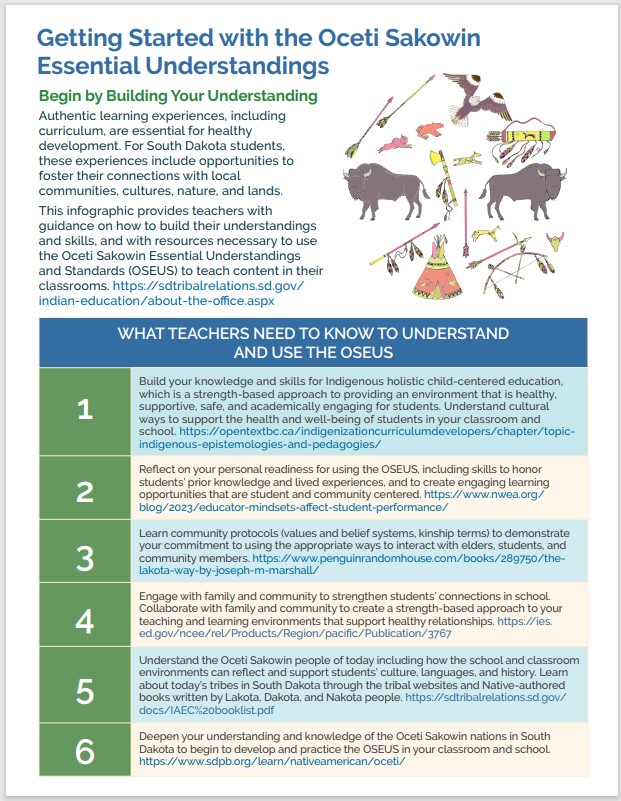By Dorothy Aguilera-Black Bear and Susan Shebby
Building on momentum from the 2017–19 WoLakota project, the South Dakota Department of Education (SDDOE) and SD Tribal Relations Department Office of Indian Education recently partnered with the Region 11 Comprehensive Center (R11CC) for the Bright Spots project. Focused on reigniting teachers’ interest and commitment to implementing the Oceti Sakowin Essential Understandings and Standards (OSEUS) in their instruction, the project sought to develop new pathways through professional learning opportunities, curriculum development, and networking supports.
Strong collaborative partnerships would be foundational to this work. The R11CC team worked with SDDOE and Tribal Nation education agencies to build common understandings and identify focus areas that leaned into the OSEUS implementation in classrooms across the state. One of those focus areas resulted in the collaboration with educators from across the state to identify evidence-based practices (EBPs) and pedagogies and organize these in the OSEUS Integration Guide for Teachers.
To better understand how this guide could support teachers in building their skills and use of the OSEUS in their instruction, the team conducted a pilot school study. The study revealed that teachers needed additional resources and supports to build their skills and confidence integrating the OSEUS into their instruction.
Resources to Support Teachers with Implementation
In collaboration with the state’s education agencies, the R11CC team worked to expand the curriculum development supports for lesson plans that would integrate and align the OSEUS with content standards, identify appropriate curriculum resources like children’s books authored by Native Americans, and localize curriculum resources and language usage. The team worked with pilot school teachers to co-design a lesson plan template that is interdisciplinary with content standards and the OSEUS. The R11CC team then collaborated with pilot school teachers to improve on the lesson plan template design and to create a resource based on the EBPs and concepts from the Integration Guide.
Recognizing the need for teachers to have additional resources to better understand the EBPs associated with teaching the OSEUS, the R11CC team created an At-a-Glance infographic that includes key steps to understanding and using the OSEUS.
This infographic provides teachers with guidance on how to build their understandings and skills and provides necessary resources to use the OSEUS to teach content in their classrooms. The infographic highlights six steps for teachers to gain the understandings and skills through additional resources that dig deeper into the EBPs for integrating the OSEUS:
- Build your knowledge and skills for Indigenous holistic child-centered education that provides an environment that is healthy, supportive, safe and academically engaging for students.
- Reflect on your personal readiness for using the OSEUS, including skills to honor student’s prior knowledge and experiences and to create engaging learning opportunities that are student and community centered.
- Learn community protocols (values and belief systems, kinship terms) to demonstrate your commitment to using the appropriate ways to interact with elders, students, and community members.
- Engage with family and community to strengthen students’ connections in school.
- Understand the Oceti Sakowin people of today including how the school and classroom environments can reflect and support students’ culture, languages, and history.
- Deepen your understanding and knowledge of the Oceti Sakowin nations in South Dakota to begin to develop and practice the OSEUS in your classroom and school.
In response to teachers asking for more guidance on getting started with teaching the OSEUS, the R11CC team included an “After Building Your Understanding” section in the infographic, covering three key additional supports for implementation:
- OSEUS Lesson Plan Development
- Collaboration and Planning
- Continuous Improvement
As a result of this work, the OSEUS are gaining more widespread use in schools across the state, helping school leaders, teachers, students, and families strengthen their understanding of Oceti Sakowin history, language, and culture. The Bright Spots project resources will go a long way in the OSEUS implementation momentum and with sustaining this work in the future.
Learn more to begin your journey to use the OSEUS in your classroom and school with these resources:
- Download the At-a-Glance infographic
- Download the OSEUS Integration Guide for Teachers
- Download the lesson plan template
- Visit the R11CC project page
- Visit the South Dakota Tribal Relations Department, Office of Indian Education project page

